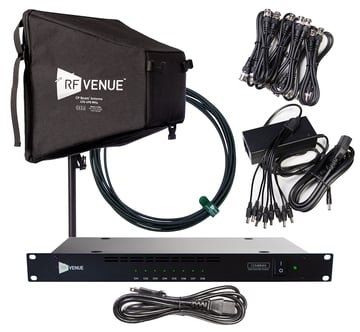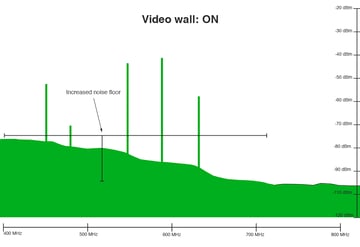- Products
- All Products
- RF PA Extension Kit
- Wireless Microphone Upgrade Packs
- In-Ear Monitor Upgrade Packs
- Wireless Microphone Antennas
- Wireless In-Ear Monitor Antennas
- Antenna Distribution for Microphones
- Antenna Combiners for In-Ear Monitors
- Multi-Zone Antenna Combiners
- Spectrum Tools
- Accessories, Cables and Parts
- Solutions by Venue
- Resources & Training
- Performance Tools
- About Us
August 14, 2023
The Top Three Wireless Microphone Problems and How to Solve Them
Written by: Don Boomer
Wireless microphones are prone to interference, noise, drop-outs, and many other RF problems.
These problems can be disastrous for both live productions and installed systems. Everyone can recall a time when a wireless mic suffered static or intermittent dropouts during a live event. Malfunctions lasting even a fraction of a second can throw off presentations and performances- driving technical crews, event coordinators, and audiences crazy. Below are the three most common problems, and a few basic techniques to solve them.
Get Started, Free! Where is your project located?
Wireless System Builder is designed for a maximum system size of 25 channels of wireless mics and 16 channels of IEMs.
For best performance use Google Chrome on a desktop computer.
1. Multi-path Interference
Multi-path interference is when portions of RF energy arriving at the receiver's antenna at slightly different times. You may remember an example of this as "ghosts" in the analog TV days. Radio waves always travel as straight lines, so to get around a corner they must bounce. As a transmitted wave spreads, it encounters surfaces that reflect or absorb different parts of the wave. As these waves bounce off of and around surfaces, they arrive at the receiver at slightly different times and thus out of phase—creating dropouts and dead-spots for wireless microphones. Also the polarity of the wave flips 180 degrees every time it reflects off a surface. When these signals mix in your antenna they almost always cause signal cancellation and therefore drop outs. This is a common problem for wireless microphone systems indoors, where there are a multitude of opportunities for RF to reflect off surfaces.
Multi-path is particularly problematic for microphones since they are constantly in motion and changing angles. So before showtime, diagnose your performance space for multi-path by simulating the motion of the talent, and walk around the entire area with a mic while monitoring RF signal level and audio at the receiver position.
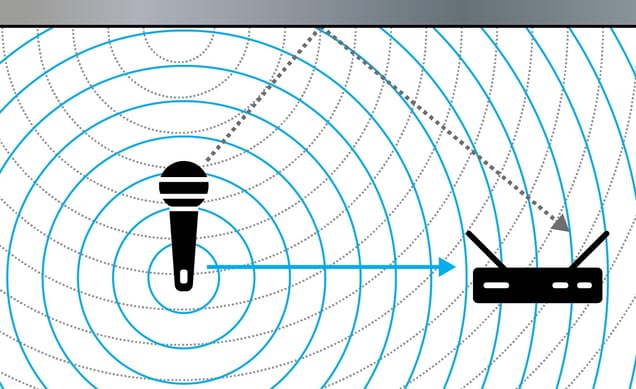
Reducing multi-path interference is usually straight forward. The diversity microphone receiver was designed to reduce interference caused by multi-path, and virtually all professional mic systems use this scheme today. They use two antennas that have different perspectives, instead of one, and employ a switching function that discriminates between the relative strength of the two signals. The odds that a null develops at both antennas is much lower than with a single antenna. Manufacturers use multiple schemes for diversity and some work better than others.
However, the design of the diversity receiver can solve one problem while introducing another: a poor signal will often cause the system to rapidly switch back and forth between antennas, leading to quick dropouts and "swooshing" sounds caused by switching noise.
If your system encounters multi-path interference the first thing to do is to relocate your receivers—or better yet, install a good remote antenna system. Employing a polarization diversity antenna like the Diversity Fin or Diversity Architectural will eliminate cross polarization dropouts by providing the receiver with an improved signal on both branches of the diversity switching function. It doesn't drop out! This causes receivers to maintain quality signal without all the switching and signal dropouts. For additional information about polarization diversity and its advantages be sure to download our free eBook on that topic here.
To learn more, check out the first session of the 12 part weekly RF Expert video series
2. Noise Floor and Interference
It's important to understand that all environments are a soup of radio waves. Most of that energy is caused by other electronic devices emitting stray (unintended) RF—computers, video walls, LED lighting, power supplies, anything with a motor —just about any powered device. And even in the remotest desert, cosmic radiation and natural radiation generated by the earth causes noise. Worse yet, noise is often intermittent- present during show time but gone the next day. We cover other common sources of interference for wireless mics in a post here.
An RF system—like a wireless microphone—needs a sufficient signal-to-noise ratio (AKA - carrier-to-noise ratio) to stay above this ever-present ambient noise “floor.” Maintaining high signal-to-noise ratio for your wireless mics is aided by isolating the signal and directing it to only where it is needed. In general, the closer the wireless receivers (or remote antennas) are to the wireless mics, the better. This provides the transmitter and receiver a shorter distance and stronger signal, which presents a higher signal over the noise floor, which usually doesn't change, at the receiver.
We would hope that the ambient noise floor at our venue is about -80dB or lower but with some planning and the use of best practices, noise floors of -70dB and higher are usually workable. Here's how to measure the noise floor and interference at your location with an RF spectrum analyzer- a must have in today's increasingly crowded RF environment.
"Paddle" or "shark fin" antennas may have difficulty keeping up in the presence of these higher noise floor scenarios so selecting a local field antenna like the Spotlight antenna can isolate reception and decrease the amount of noise entering the signal chain, significantly opening up even the most crowded RF environments to accommodate your system. Additionally, adding the appropriate Band Pass Filter can typically reduce your noise floor by 6 to 15 dB! The use of top quality, 100% shielded coax cables can reduce the ingress of stray RF into your system as well. Using these specialized antennas and signal management techniques can be the difference between success and failure:
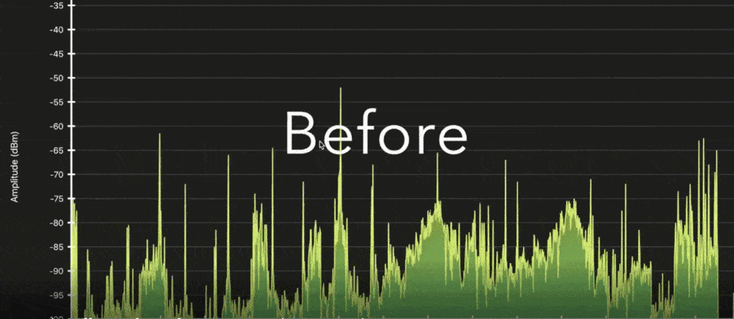
Managing noise with the Spotlight Antenna and RF Bandpass Filters
3. Intermodulation Distortion and Frequency Coordination
Frequency coordination is essential in wireless systems (now easier than ever with RF Venue's Wireless System Builder) to avoid not only third party transmitters but also the harmful effects of Intermodulation Distortion (also referred to as IMD or "intermod"). IMD is the result of two or more signals passing through a non-linear device, such as a diode or an amplifier. IMD manifests as ghost signals from wireless mic bodypack or handheld transmitters. These appear at predictable frequencies in the RF spectrum. If these ghosts are too close to one of the frequencies used by your microphone, audible distortion can result.
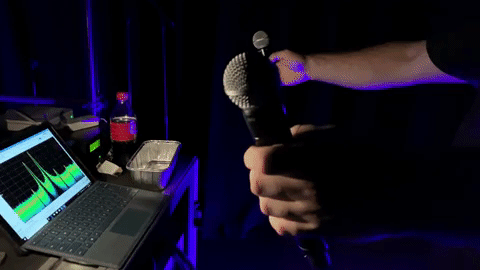
Demonstrating intermodulation distortion (IMD)
By carefully selecting frequencies you can force the IM to occur only at frequencies that we don’t care about, and avoid those interference events altogether. This is most commonly achieved through determining an "intermod-free" set of frequencies, which can be accomplished through various software tools like RF Venue's Wireless System Builder, or Shure's Wireless Workbench, IAS, Wireless Manager and even onboard some receivers. But getting an elegant solution from these programs requires providing them with the best possible data. Many users connect their receivers as the scanning input, but remember, a receiver can only input the band it can receive and so no out of band information is provided for the calculations.
The importance of frequency coordination in today's scene can not be understated as the wireless landscape continues to evolve with more and more devices competing for less available spectrum. Moving towards the July 2020 deadline for repacking the UHF band, it may become very difficult to use wireless mics without the frequency selections derived by these algorithms. So with each new spectrum change the challenges faced by audio professionals multiply. But thankfully, new methods and technologies are emerging to confront these problems and narrow the gap between the performance of wired and wireless systems. Be sure to examine other posts in our blog and subscribe to get bi-monthly updates on the latest.
Have a wireless microphone project or install and need help? Please contact us here
And for more tips be sure to download our FREE Three Essential Concepts eBook:
Don Boomer
Don Boomer is Senior applications engineer at RF Venue. He has worked in R&D in the past for Peavey, Sabine and Line 6 and his rock band from his high school days has a song in the Rock n Roll Hall of Fame
More from the blog
Subscribe to email updates
Stay up-to-date on what's happening at this blog and get additional content about the benefits of subscribing.


